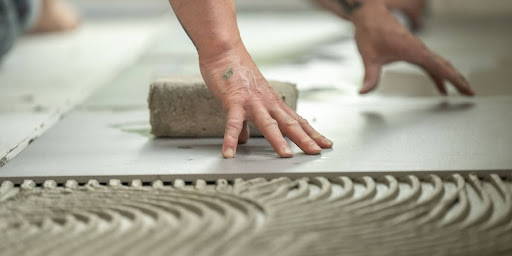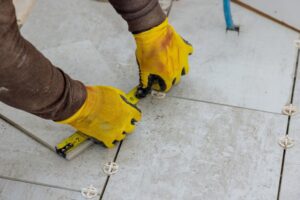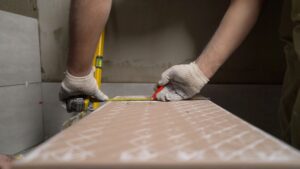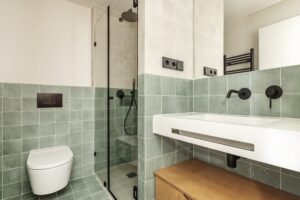‘How long does it take to fit a bathroom’? This is the question that acts as one of the biggest barriers to people fulfilling their dream of a brand-new bathroom. But the question of ‘how long does a bathroom take to fit’ shouldn’t prevent you from going through with the work, especially as the benefits of a new washroom far outweigh the necessary effort.
Explore bathroom suites, tiles and accessories from us to simplify your renovation process. At Raynesway Tile Warehouse we boast an outstanding collection of bathroom products and various stylish tile designs that will elevate your space. From our wall and floor tiles to our underfloor heating, at Raynesway we can help you make the bathroom of your domestic dreams a reality.
But, that’s enough about us, let’s get into how long you can expect to be renovating your bathroom before you can bask in its delights.
So, how long does it take to fit a new bathroom?
Since bathroom suites vary in size, shape and complexity, it is difficult to put a set amount of time on the question of ‘how long does it take to fit a bathroom’. A small renovation, for example, that merely addresses replacing fixtures, can take around a week, whereas a new custom bathroom suite with underfloor heating, high-end tiling and a full restructure can take double that time.
When considering how long a bathroom renovation might take, it’s important to consider the biggest factors that will affect the task ahead.
The biggest factors affecting bathroom installation time
There is a big difference between a small bathroom renovation spruce and a luxurious transformation, so let’s get into what might affect how long it takes for you to get the job done.
Who is carrying out the renovation?
If you fancy yourself as a budding interior designer with a handy eye for DIY, you may consider doing the bathroom renovation on your own. This will cost a small margin of the price that you would have paid to get a reputable contractor to do the job for you, but it will mean that you’ll likely have to take time out of your busy schedule to get the job done.
Indeed, bathroom renovations involve the need for specialist knowledge, including, but not limited to plumbing, wiring and tiling. You may find it more cost and time-effective to simply hire highly skilled tradespeople to do these jobs for you.
Working faster and more efficiently than you likely could, hiring a team of specialists will also make it far less likely that you will experience major long-term issues with the space, which may occur if you don’t give the task the time, effort and attention required.
What work is being carried out?
Before you begin any work, make a comprehensive list of everything you want from a new bathroom, planning the whole space so you get it right first time. Do you want extensive tiling done, a new bath, multiple radiators, an extractor fan replacement? Once you’ve got this list, you’ll get a better idea of how long the task might take – the more you have listed, the longer it will likely take to complete the job.
Some tasks take far longer than others, depending on exactly what you’re looking for. For example, basic vinyl flooring will save you time in comparison to the installation of porcelain or quality ceramic tiles, which requires expert skill, specialist tools and drying time, but we’d argue that the latter gives a far better finish! Once you’ve made your list of what needs to be done, research how long each task might take and adjust your expectations accordingly.
But before you start any work, consider if any complex structural changes are necessary, as this will further impact how long your renovation will take.
How complex are the structural changes?
When it comes to the question of ‘how long does it take to fit a bathroom’, the possibility of structural changes to the space may be the biggest contributing factor. Structural changes, such as a reworking of the plumbing or electrical systems when installing a shower, toilet, mirror or otherwise, should always be carried out by a professional.
Depending on just how different you want the renovation to be, it will be likely that other technical tasks will need to be carried out, such as plastering, which will only add to the duration of the work. This further adds to the argument that it’s often better to leave the complexity of a bathroom renovation to the experts, avoiding the possibility of causing unintentional damage that may require more money and time to fix.
Make sure you leave time for tiling
Extraordinary tiles can easily give your renovated bathroom a new lease of life! But it’s also important to factor in just how long it can take to tile the room, particularly if you’re covering the walls and the floor. Depending on the size of the job, tiling a whole bathroom can take around a two days if you’re tirelessly working on it. But, if the space is awkwardly sized and intricate, the time needed for tile cutting could extend the estimated duration.
Since tiling is a skilled profession, we’d advise getting an expert in to complete the job – we can even personally recommend the very best companies that we’ve worked with. Although tiling walls may seem simple, it is delicate and time-consuming, particularly if you’ve never partaken in plastering before, so it’s best left to the pros.
How much does a new bathroom renovation cost?
The average price of a new bathroom is approximately £5,000 to £8,000. The cost can exceed these figures depending on the types of products chosen.
Just like how it’s tricky to provide an accurate time frame for how long your own bathroom renovation might take due to the unique nature of each conversion, the same goes for the total overall cost. For example, you may be looking to renovate your bathroom with the aim of increasing your house price by including beneficial luxury options like underfloor heating. Or, you may prefer something straightforward, simple and rustic. Both options will result in wildly different total expenditures.
How to save money on a bathroom renovation
But just because a bathroom renovation could set you back a lot of money, this doesn’t mean you can’t be economical at the very same time. There are several ways in which you can save money on a bathroom renovation without sacrificing quality. So, if you’re looking to save your wallet from a dramatic impact, consider the following tips.
- Plan and budget: Create a comprehensive plan of what you want to do and estimate a budget. Try to stick to this budget when looking for materials and approaching tradespeople
- DIY: ‘Doing it yourself’ is one of the very best ways to save money on a bathroom renovation, with labour costs requiring most of your budget. But, to do thi,s you’ll have to learn skills like how to measure a bathroom for tiles.
- Don’t change the layout: Changing the entire layout of your space means removing and rerouting wires and plumbing. You can save money by just refreshing your previous setup.
- Use ceramic tiles: Depending on what kind of look and feel you want for your space, consider using ceramic tiles as these are both aesthetically pleasing and easy on your budget too.
- Upcycle: Just because you’re having a whole bathroom renovation doesn’t mean you have to replace all your fixtures. If your bath, sink or shower just needs a bit of TLC before re-installing, consider doing this to save some cash.
Raynesway Tile Warehouse can be your perfect partner
Fitting a quality bathroom renovation in good time while keeping costs to a minimum is a challenge, but at Raynesway Tile Warehouse, we try to keep things simple for you. Offering expertise, quality materials and even professional tools for sale, we are a local, family-owned business that has over a decade of experience in the industry.
But don’t just take our word for it when it comes to our credentials – just read one of our many glowing testimonials from one of our many happy customers.
‘Great customer service! Excellent advice from Wayne and the gang – friendly, professional and was a hugely pleasant process from choosing my tiles to having it delivered. Highly recommend!’ – Mickey
We don’t just deal in bathrooms, either. If you complete your bathroom and fancy giving your kitchen a dash of new life, why not explore our kitchen tiles for sale and get your creative cogs whirring? If you’re ready to get renovating, contact us today and we’ll happily help you take your first steps.






FOLLOW US